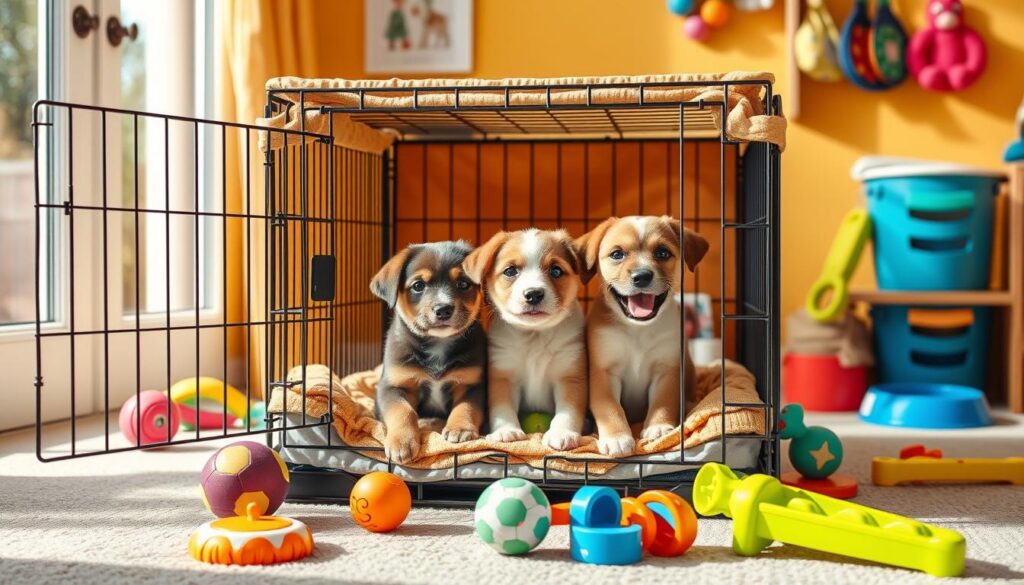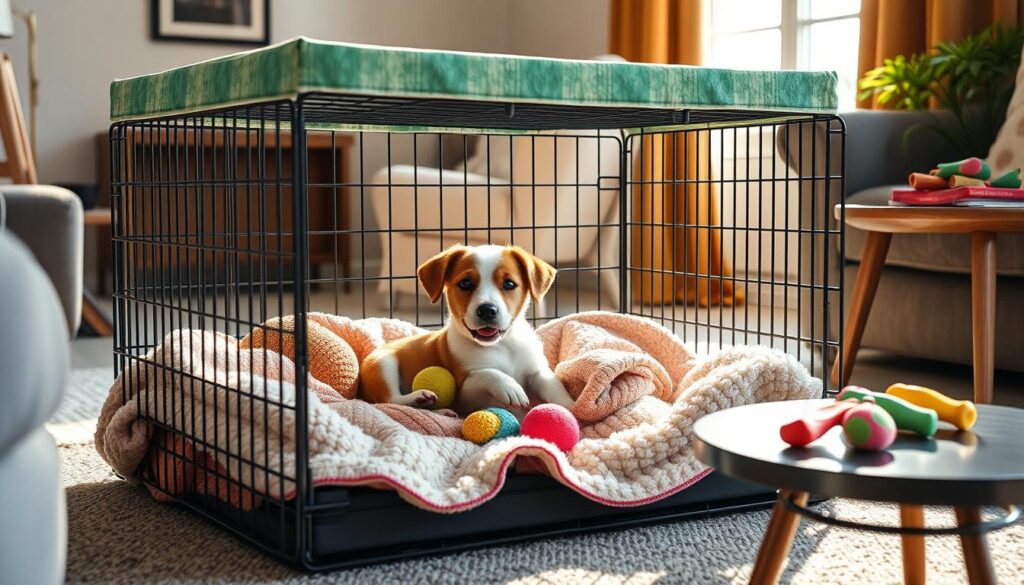Crate Sharing: Can You Put Two Puppies in One Crate?

Imagine bringing home two cute puppies and wanting to start crate training. You might think, “Can I put both puppies in one crate?” This question is common for new pet owners but the answer is not straightforward.
Experts say it’s not a good idea to put two puppies in one crate. It might seem cozy, but it can cause problems. Puppies need their own space to feel safe and happy. As they grow, having separate crates is key for their well-being and training, but there are times when it’s okay. Very young puppies, for example, under 8 weeks, might like to share a crate. They’re used to being close to their siblings.
Key Takeaways
- Crating two puppies together is generally not recommended for safety and training reasons.
- Very young puppies under 8 weeks may be an exception to the rule.
- Separate crates promote individual development and prevent behavioral issues.
- Using exercise pens can be a safer alternative for housing multiple puppies.
- Proper crate training helps puppies feel secure and aids in housebreaking.
The Basics of Crate Training
Crate training is a key part of raising a well-behaved puppy. It takes time and patience, but the rewards are great.
What is Crate Training?
Crate training uses a dog’s natural den instinct to create a safe space and it teaches your puppy to see their crate as a cozy retreat. Puppy crate training techniques vary, but all aim for positive associations. We really want to make sure your puppy loves it’s ”den”.
Why Crate Training is Important
There are many benefits of crate training. It helps with:
- housebreaking
- prevents destructive behavior
- offers a secure resting area
- Helps with potty training
- Provides a safe space for your puppy
- Reduces anxiety when left alone
- Makes travel easier
It’s a tool for managing behavior, not a punishment.
Remember, crate training is a tool for managing behavior and not a punishment. It can take days or weeks, it all depends on your puppy’s age, temperament and breed. Start with short periods and gradually increase the time but make sure to never leave a puppy under 6 months in a crate for more than 3-4 hours.
With patience and consistency, your puppy will grow to love their crate and once crate-trained, your puppy won’t leave its crate. Just kidding but also not really. Sometimes I have huge troubles getting my dog out of it, especially in the morning or evenings. Nothing a small piece of chicken can’t solve.
To learn more about crate training, read our ”How to crate train a puppy” guide.

Can You Crate Two Puppies Together?

Many dog owners wonder if it’s okay to crate two puppies at once. Some think it’s easy, but experts usually say no. Let’s look at what they recommend and the possible dangers.
General Recommendations
Most trainers say no to crating two puppies together, because they believe it’s better for each puppy to have its own crate. This way, each puppy gets the attention and training it needs as it also teaches them to be independent. This also helps to prevent littermate syndrome. That just means puppies bond too strong together which will cause problems in the dog’s future development. I will cover that part in the next section, but very briefly.
Risks and Challenges
| Risks | Challenges |
|---|---|
| Fights between puppies | Managing limited space |
| Increased anxiety | Ensuring equal attention |
| Hindered individual growth | Preventing over-bonding |
| Littermate syndrome | Individualized training |
Getting two puppies at once means double the work. You’ll spend more on food, vet bills, and training. Think carefully before deciding to crate multiple puppies together.
Behavioral Considerations

Understanding Puppy Dynamics
Puppies must grow their own personalities and bond with their family and raising two puppies together can make them too dependent on each other. This can cause behavioral and social issues. Puppies might get scared from other dogs or people or they might develop a severe separation anxiety.
Littermate Syndrome
Littermate syndrome is a big worry with two puppies from the same litter or close in age. It can cause:
- Increased shyness and fear of people
- Failure to bond with humans
- Co-dependency between puppies
- Potential aggression between the puppies
- Difficulty in training and socialization
Even skilled dog trainers struggle to avoid littermate syndrome and guide dog groups now avoid placing two puppies together because of these problems.
| Aspect | Single Puppy | Two Puppies |
|---|---|---|
| Training Effectiveness | High | Lower |
| Bonding with Humans | Strong | Potentially Weak |
| Independence | Develops Naturally | May Be Hindered |
| Socialization | Easier | More Challenging |
To help puppies grow well, it’s best to bring them home separately. Wait at least six months before adding another puppy. This way, each puppy can fully develop their behavior and social skills. Or if you really want two puppies, get them separate crates.
Best Practices for Crating Two Puppies
Setting up a puppy crate in homes with multiple dogs needs careful planning. It’s tempting to keep two puppies together. But, individual crates are often the best choice. Let’s look at the pros and cons of different crate setups and how to introduce shared crate time safely.
Individual Crates vs. Shared Crate
Experts say separate crates are best for each puppy because it helps to prevent separation anxiety and lets puppies develop their own identities. Puppies should sleep in separate crates within two weeks of coming home.
Gradual Introduction to Shared Crate Time
If you want to try shared crate time, do it slowly and watch closely. Start with short times and keep an eye on their behavior. Make sure each puppy has their own bed and toys in the crate to avoid fights.
Remember, raising two puppies can be much messier than one. So, get ready for more chaos!
| Crate Type | Pros | Cons |
|---|---|---|
| Individual Crates | Prevents separation anxiety, Fosters independence | Requires more space, Higher initial cost |
| Shared Crate | Saves space, Can comfort each other | Risk of overattachment, Potential for conflicts |
In homes with multiple dogs, it’s important to balance time with each puppy. Spend time alone with each to strengthen your bond and to do proper, undisturbed training. When you’re done, swap out the puppies.
Go to puppy classes separately. Tailor sessions to each pup’s needs for better learning.
Training Strategies for Multiple Puppies

Training multiple puppies is rewarding but also challenging. It needs careful planning and consistent effort.
Separate Training Sessions
When training multiple puppies, giving each one your full attention is crucial. Train one puppy at a time, for about five to ten minutes. This lets you focus on each puppy’s needs and avoid distractions.
Use station training to teach patience. Give each puppy its own spot while you work with another. This helps them learn to wait and prevents them from interrupting each other.
Gradual Socialization Techniques
Teaching puppies to socialize is very important. Start by teaching them to recognize their names and introduce them to new things, people, and other dogs slowly.
Make sure to spend special time with each puppy every day. This one-on-one time strengthens your bond and meets their individual needs. Remember, each puppy is different, so adjust your training to fit their unique needs.
| Training Aspect | Recommendation |
|---|---|
| Session Duration | 5-10 minutes per puppy |
| Training Approach | Individual sessions |
| Socialization Method | Gradual exposure |
| Daily Solo Time | Rotate 5-minute sessions |
By using these strategies, you’ll lay a solid foundation for your puppies’ growth. Always remember, being consistent and patient is key in training multiple puppies. To learn more about training two puppies, read our ”How to crate train two puppies” guide.

Troubleshooting Common Issues
Managing a multi-dog household can be tough. You might deal with puppy anxiety and competition. Let’s find ways to solve these problems and make a peaceful home for your dogs.
Addressing Anxiety and Fear
Puppy anxiety shows when dogs are separated or crated. Look for signs like whining, pacing, or destructive acts. To make your puppies feel safe:
- Create positive crate associations with treats and toys
- Gradually increase crate time to build confidence
- Use calming music or pheromone diffusers to reduce stress
- Ensure each puppy gets individual attention and outings
Managing Jealousy or Competition
In multi-dog homes, jealousy can happen. To lessen fights:
- Provide separate feeding areas and individual toys
- Offer equal attention and training time to each puppy
- Reward calm behavior and sharing
- Teach the “Leave It” command to prevent resource guarding
Remember, being consistent is crucial in solving these problems. If issues keep coming up, get help from a dog trainer or behaviorist who knows about multi-dog homes.
| Issue | Solution |
|---|---|
| Puppy Anxiety | Positive crate associations, gradual desensitization |
| Jealousy | Equal attention, separate resources |
| Resource Guarding | Train “Leave It” command, reward sharing |
Expert Advice and Resources
Training multiple puppies needs the right help and resources. This guide will show you how to find them.
When to Seek Professional Help
Know when to get help from professional dog trainers:
- Persistent behavioral issues like aggression or anxiety
- Difficulty in basic training or housebreaking
- Challenges in managing multiple puppies
- Signs of littermate syndrome, such as over-attachment between puppies
Recommended Resources
Check out these puppy training resources to improve your skills:
- Books on positive reinforcement techniques
- Online courses focusing on multiple puppy training
- Local puppy training classes for hands-on experience
- Reputable dog training websites and forums
Raising multiple puppies takes a lot of work. Professional dog trainers offer personalized advice. Quality puppy training resources provide ongoing support. With expert help and self-education, you’ll raise happy, well-behaved puppies.
I can highly recommend this course: K9 Training Industry. It offers a free workshop and is hosted by dog behavior specialist Alexa Diaz. She has more than 20 years of experience in training dogs.
Conclusion
Raising multiple puppies can be very rewarding. But, it also comes with its own set of challenges. Experts usually say not to crate two puppies together. This is because separate crates help each puppy grow, learn, and bond with humans better.


